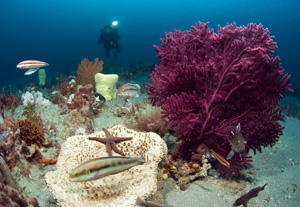New sanctuary research area to help improve understanding of important habitats
Minimal economic effects seen from closing lightly used area to fishing, diving
October 13, 2011
The southern third of NOAA’s 22-square mile Gray’s Reef National Marine Sanctuary off the Georgia coast was designated a research area, where scientists can study how human activities and natural processes affect the sanctuary’s marine resources. The new designation will take effect after a 45-day Congressional review.
This new research area is specifically designed for conducting controlled scientific studies where human activities cannot affect the results. Fishing and diving will be prohibited in the lightly used, 8-square mile research area, which currently hosts no commercial fishing. Vessels will be permitted to travel through it without stopping.
Scientists will be able to design and implement habitat studies where critical variables can be controlled over long periods of time. The research area will provide managers with the high-caliber science needed to improve understanding of the effects of human activities on the sanctuary’s natural resources. The designated research area is relatively free of human activity, and therefore, it can be studied and compared to the rest of the sanctuary.
The research area will help scientists study how natural events such as hurricanes and droughts affect the sanctuary, and serve as a place to monitor and study the effects of climate change and ocean acidification.
“Having an area where scientists can compare natural processes with human-induced change in the sanctuary will help us better understand how humans affect live-bottom habitats like Gray’s Reef,” said George Sedberry, sanctuary superintendent.
The idea for a research area in the sanctuary was first raised in 1999 at public scoping meetings during the early stages of the sanctuary’s management plan review process. A working group representing a variety of sanctuary users including recreational and commercial fishing, sport diving groups, academic institutions, conservation group as well as law enforcement and state and federal agency representatives endorsed the research area concept.
Danny Gleason, a biology professor at Georgia Southern University who has conducted research in the sanctuary and nearby live-bottom reefs since 2000, said the location of Gray’s Reef makes it valuable as a “sentinel site” for detecting the northern movement of species that might result under global climate change.
“Incorporating a research area into the sanctuary will improve vastly our ability to detect such long-term changes in ecosystem structure and function because variability resulting from other human impacts, such as the removal of fish, will be reduced significantly,” Gleason said. “Gaining such knowledge is critical to managing this resource for multiple uses in a rapidly changing world.”
NOAA’s Office of National Marine Sanctuaries received comments during a public comment period for the proposed rule held in March and April 2008. NOAA chose the research area’s boundary based on comments and the preferences voiced by most sanctuary users during the 2008 public scoping. It is expected to affect few sanctuary visitors. The final rule was posted online today, and will be published in the Federal Register on Friday, Oct. 14. Complete details of the new regulation, including the Federal Register notice, can be found online.
Designated in 1981, NOAA’s Gray’s Reef National Marine Sanctuary is one of the largest near-shore live-bottom reefs off the southeastern United States, encompassing approximately 22 square miles. The live bottom and ledge habitat support an abundant reef fish and invertebrate community. Loggerhead sea turtles, a threatened species, also use Gray’s Reef year-round for foraging and resting, and highly endangered North Atlantic right whales are occasionally seen in the sanctuary.
NOAA’s mission is to understand and predict changes in the Earth's environment, from the depths of the ocean to the surface of the sun, and to conserve and manage our coastal and marine resources. Join us on Facebook, Twitter and our other social media channels.


